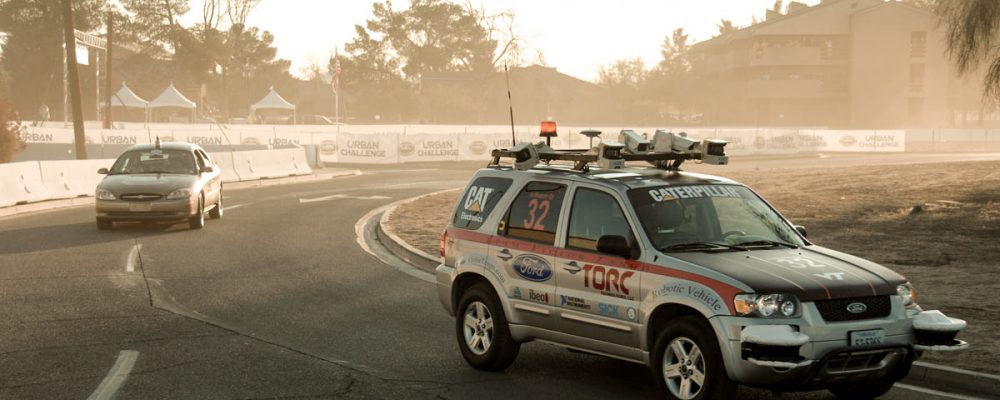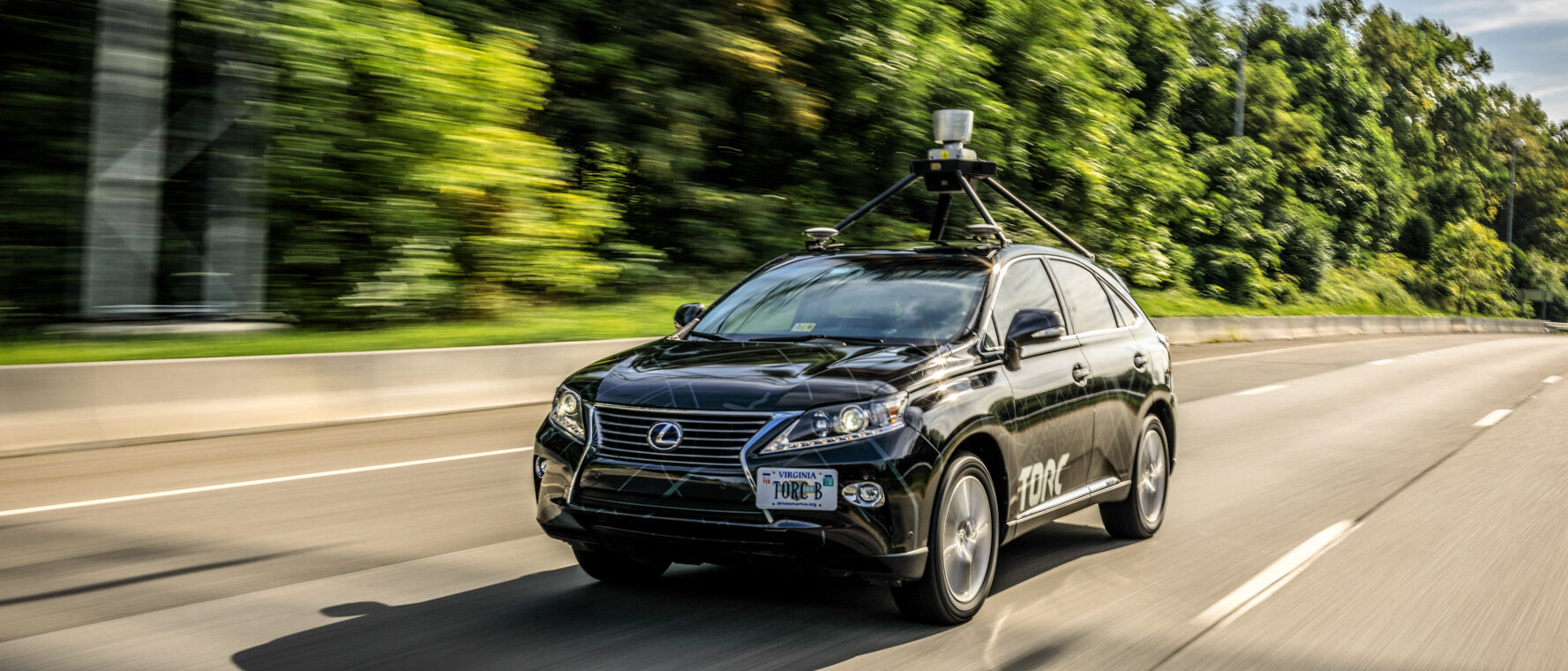Torc Robotics
Self-driving technology firm that has developed a complete self-driving system for consumer automobiles using technology that Torc has developed over the past decade for safety-critical situations such as mobility, mining and defense.
Employs: 100
Torc Robotics was born from competition
In 2005, a group of Virginia Tech student engineers designed and built three autonomous vehicles for the AUVSI Intelligent Ground Vehicle Competition. After three rigorous days, competing against 27 teams, the students swept the competition placing first, second, and third.
Later that year, the students built two other autonomous vehicles to compete in the DARPA Grand Challenge. Out of 195 applicants, the team placed eighth and ninth, completing 100 combined miles of autonomous driving in harsh, rocky desert terrain.
Those victories generated interest from the automotive, mining and defense industries.

Keeping the band together
Torc was founded in 2005 to commercialize the technology and keep the team together. The company name was selected as a play on the word “torque,” and implied the team’s technology controlled the steering wheel to drive an autonomous vehicle.
The company opened an office in the Virginia Tech Corporate Research Center and enrolled in the VTKnowledgeWorks technology incubator.
Shortly thereafter, DARPA announced its next robotic challenge. The 2007 DARPA Urban Challenge was a 60-mile race through urban and off-road terrain. Unlike previous challenges, other manned and autonomous vehicles would be on the course at the same time.
Torc worked with Virginia Tech to form team VictorTango, which was awarded one of the $1 million DARPA grants. The team finished third out of 89 teams, completing the event in four hours and 36 minutes.
Since then, Torc has retained the majority of its original team and continuously improved upon its technology — successfully applying it to a variety of commercial ground vehicles, from large mining trucks to military vehicles, and more recently to self-driving cars.
Michael Fleming, Torc Robotics CEO and co-founder, describes his company’s technological process as a “consistent evolution.”
“Sometimes it’s one step back and two steps forward,” he said. “Great things are not accomplished in short order.”
For more than a decade, Torc’s research and development, engineering and consulting services have helped leaders in a wide range of industries put advanced robotics and on- and off-road self-driving automobile technologies to work, helping their businesses operate safer, smarter and more efficiently.
Saving lives by eliminating human error
Torc’s complete self-driving system works to reduce crashes caused by human error. “Our goal is to save lives,” Fleming emphasized. The company’s system performs a See-Think-Act process while driving. The system perceives the environment, plans how to react, then controls or implements the behavior.
We have been waiting for the time when it would be feasible to apply to consumer cars. That time is now.”
—Michael Fleming
Torc’s technology:
- Balances proven and emerging algorithms such as deep learning. The multi-sensor (vision, LiDAR, and radar) approach enables Torc’s self-driving solutions to operate in non-ideal weather conditions.
- Integrates route planning, behaviors and motion planning.
- Provides the appropriate actuation of vehicle control and monitoring of vehicle feedback to obtain motion planning’s desired path.
- Controls every decision made throughout the autonomous system and bases those decisions on raw sensor data to ensure intelligence, reliability, and trustworthiness.
“We have been developing our autonomous systems and have resolved issues in hazardous environments with no or little pavement. Applying our technology to the safer, engineered paths of modern roads is a logical step,” Fleming said.
“We have been waiting for the time when it would be feasible to apply to consumer cars. That time is now.”

Taking the show on the road
Torc implemented the technology in two Lexus RX vehicles, nicknamed “Asimov” for the famous science-fiction writer Isaac Asimov, which have been operating on public roads, in a variety of weather conditions, since February early 2017.
In April 2017, one of Torc’s self-driving vehicles logged more than 1,000 autonomous miles during a round trip from company headquarters in Blacksburg, Virginia, to the Ford Piquette Avenue Plant in Detroit — birthplace of the Model T.
In July 2017, Torc’s self-driving car completed a round- trip journey from coast to coast. The car drive from Washington, D.C., to Seattle was Washington state’s first certified pilot test. The trip ended in Richmond. The vehicle drove more than 4,300 autonomous miles — successfully navigating heavy urban traffic, aggressive tailgating, heavy rains and highway detours.
Torc took the January 2018 Consumer Electronics Show by storm.
On a day when rain caused other companies to cancel rides in their autonomous vehicles, Torc stayed on the road. “Weather clearly wasn’t a deterrent for Torc; coming out of dinner that night, I saw one of its vehicles pass me by on the street like it was no big deal,” Ryan Felton wrote in his article “How This Tiny Virginia Company Is Running Circles Around The Self-Driving Car Industry,” for Jalopnik.
Other headlines from CES included CNET’s “Torc car drives itself as well as any human at CES 2018” and Sensor Magazine’s “Torc Car Thumbs Nose At Wrong-Way Drivers.”
Torc also has successfully programmed its cars to drive in snow. The team took advantage of winter weather in the Blacksburg area to test the self-driving car system on public roads during all hours of the day and night. The weather provided challenges including snow-covered road markings, tracks from previous vehicles that weren’t centered in the lane, frozen precipitation that obscured the roof-mounted cameras and falling snow that needed to be distinguished from actual objects in the road by the car’s sensor system.
“A lot of self-driving car companies are taking on this challenge, but few have proven their ability to conquer winter weather on public streets,” Fleming said. “Asimov did so considerably well, providing valuable lessons and bringing us one step closer to having our technology ready for the consumer market.”
Torc has partnered with the American Automobile Association (AAA) to create a set of safety-guidelines for self-driving cars.
“There are a lot of different ways to integrate the complex technologies in self-driving vehicles,” Fleming said. “With a decade of trying different approaches, our team helps OEMs navigate the different options and jumpstart their programs for a fast-approaching transportation revolution.”
The partners have run tests in Nevada and California and have more tests scheduled this fall in Ohio.
Building a world-class company
Being based in Blacksburg offers Torc numerous advantages, Fleming said. Not only can the company recruit some of the best and brightest young engineers from Virginia Tech, it also can run closed-course testing on the Virginia Tech Transportation Institute Smart Road.
Virginia’s limited regulation of self-driving cars also makes it easier for the company to develop, test and validate its systems. In the past, Fleming has met with government officials to encourage them to not over regulate self-driving cars because doing so could push companies to relocate.
“Blacksburg is an ideal testing location,” Fleming said. “We have mountains, highways, fog, snow. We can take advantage of difficult driving situations.”
Torc’s technology also is used by the military to help personnel move equipment and protect them from dangers like Improvised Explosive Devices.
Caterpillar Inc., an early adopter of Torc’s autonomous vehicle technology, revealed in 2017 that the expanded autonomous technology capabilities of its Komatsu 930E mining truck were developed in part with Torc Robotics.
Looking ahead
Torc, which is a privately-held company, has grown every year and been profitable, Fleming said.
The company is in “rocket ship mode” and is expanding rapidly as it establishes some major partnerships.
Fleming said the company anticipates making several major partnership announcements in the coming months with mobility, mass transit and rideshare companies.
“We have been patiently building our company for over a decade and excited about the impact we will make with our partners in society.”